TOKYO'S FINANCIAL SYSTEM
Tokyo's Finances
Revenue
Metropolitan taxes provided for 69.1% of the settled account for metropolitan revenue in fiscal 2014. In light of the fact that local taxes accounted for just 35.0% of the total combined revenue of all local governments in fiscal 2013, the significantly large share held by local taxes in Tokyo’s revenues is a major feature of metropolitan finances.
The metropolitan government levies 16 of the local taxes listed in the Local Tax System chart on page 35. The largest proportion of total metropolitan tax revenue in fiscal 2014 came from the two corporate taxes of Corporate Enterprise Tax and Corporate Inhabitant Tax (approximately 34.7%). This is followed by the fixed Assets Tax and the City Planning Tax (approximately 28.8%)
There are several items taxed directly by the metropolitan government in the 23 special wards, which in other prefectures are not levied by the prefectural authority but rather come under municipal taxes. This is because Tokyo provides services such as fire fighting and sewerage in the ward area, which would generally be carried out by the municipality. The government thus levies these taxes to allocate funds to pay for these operations, with 55% of tax revenue obtained from three taxes—Municipal Inhabitant Tax on Corporations, the Fixed Assets Tax, and the Special Land Ownership Tax—allocated to each of the wards to provide them with their own financial resources.
National treasury disbursements hold a smaller share in overall metropolitan revenue than in that of other local governments. National treasury disbursements accounted for 16.3% of total local government finances in fiscal 2013, while it accounted for only 5.6% of metropolitan finances in fiscal 2014.
Metropolitan bonds constitute an important financial resource to develop infrastructure and for urban renewal. To avoid a future increase of financial burdens, the metropolitan government is endeavoring to refrain from any undue reliance upon the flotation of metropolitan bonds, and to contain them within an appropriate degree.
Details of Tokyo Metropolitan Government Revenue
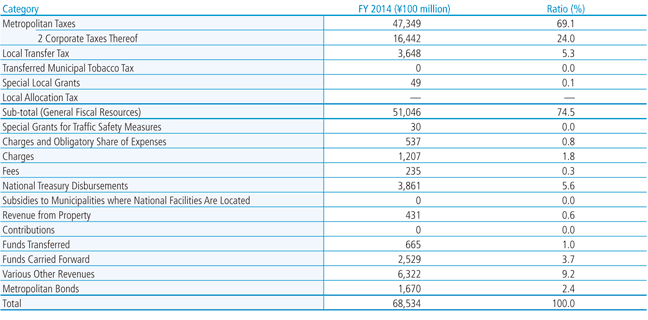
Details and Trends of Tokyo Metropolitan Government Revenue
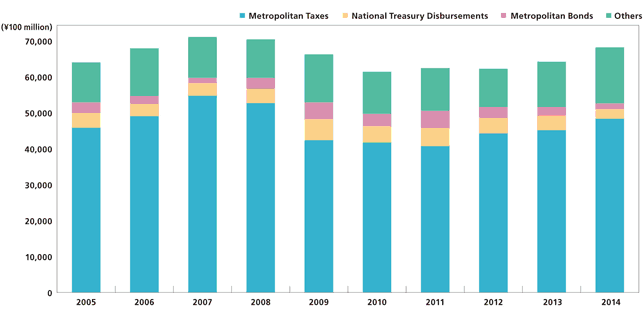
Comparison of Revenue Breakdown
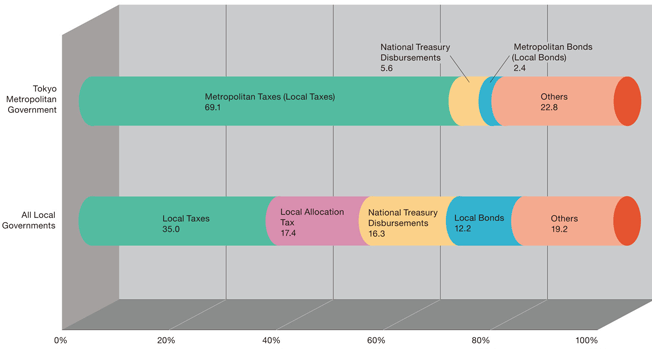
Tokyo Metropolitan Government: FY2014 Settlement of Accounts
All Local Governments: FY2013 Settlement of Accounts
Local Tax System
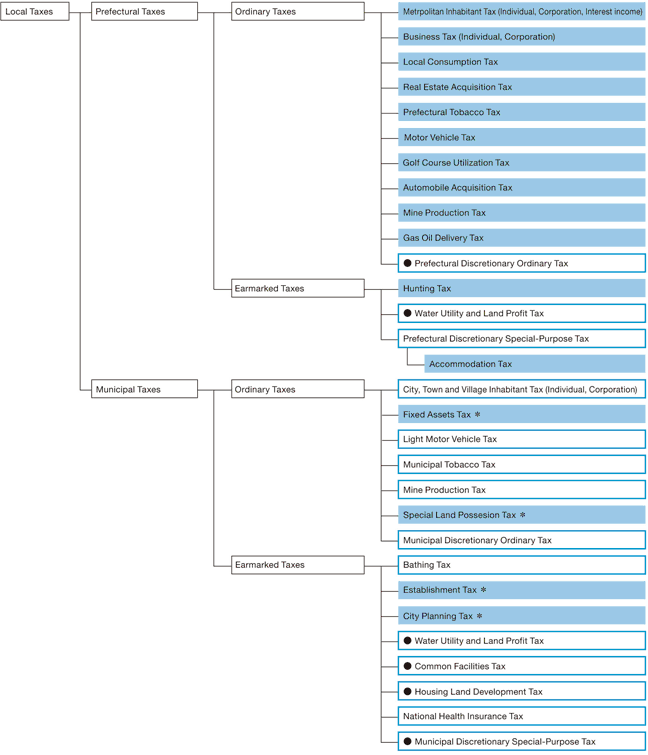
- Note 1:
- ■indicates metropolitan tax
- Note 2:
- Those marked with an asterisk are metropolitan taxes in the 23 special wards. Municipal inhabitant tax applying to corporations is imposed as metropolitan tax in the 23 special wards.
● indicates that the tax is not levied in Tokyo Metropolis.
- Note 3:
- Accommodation Tax, which is a unique tax levied by the TMG, is a prefectural discretionary special-purpose tax.
- Note 4:
- Special Land Ownership Tax has been suspended since fiscal 2003.
Breakdown of Estimated Metropolitan Tax Revenue for FY2014 (composition ratio)
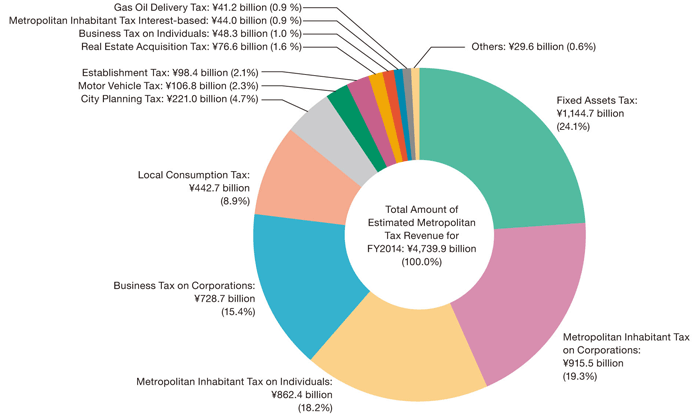
- Note 1:
- Figures shown have been rounded off. The total amount of the estimated tax revenue may not agree with the sum of the individual taxes.
Metropolitan Tax Revenue Trends (1995-2014)
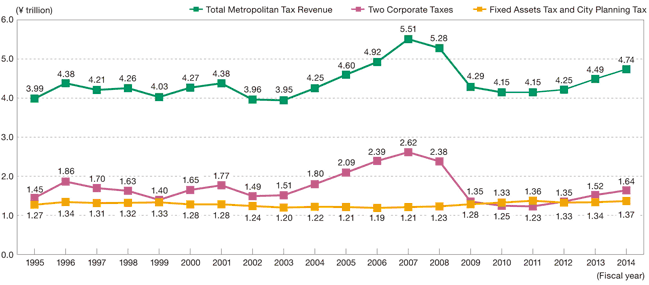
Expenditure
The expenditure of the metropolitan government has significant differences from the expenditure of other local authorities. First, the government is responsible not only for the administration at a prefectural level but also for part of the administration in the ward area, which elsewhere would be carried out at the municipal level.
Another important difference is the special ward financial adjustment allocations, an expenditure item found only in Tokyo. The special ward financial adjustment system aims to have financial resources related to the metropolitan administration fairly distributed between the metropolitan government and the 23 special wards, as well as to correct the imbalances between the 23 special wards in their fiscal strengths and ensure that they can provide an adequate level of public services.
When expenditure is viewed by type, personnel expenses constituted approximately 20% of total expenditure in fiscal 2014; the majority of this is the staff salaries of the police and fire departments, schools and other personnel directly concerned with the lives of Tokyo’s residents. Ordinary construction costs accounted for about 10% of total expenditure. These are the costs to build social infrastructure such as roads and bridges, and facilities including schools and social welfare facilities. In addition, subsidies and other expenditures, which include allocations to the special wards for financial adjustments and subsidies for facility operation costs, also made up a large proportion.
Introduction of a New Public Accounting System
Adding to the existing cash-basis accounting system, which corresponds to the budget system, in FY2006 the Tokyo Metropolitan Government (TMG) established double-entry bookkeeping and accrual-basis accounting standards that take into consideration characteristics particular to public administration. This was a first in Japan. Based on this financial accounting system unique to the metropolitan government, financial statements prepared in accordance with corporate accounting practices are released in the TMG Annual Financial Statements and other mediums.
(1) Balance Sheet (FY2014)
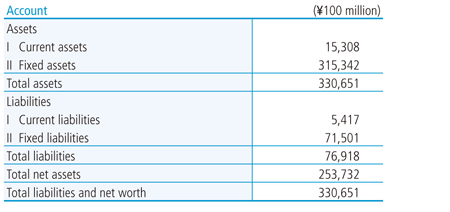
(2) Statement of Operating Costs (FY2014)
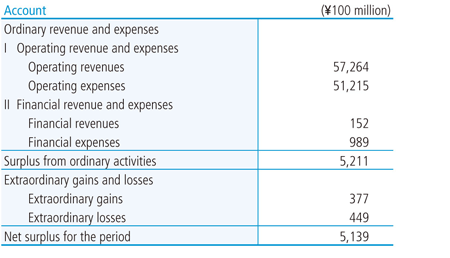
Challenges Facing Metropolitan Finances
Thanks largely to strong corporate earnings, metropolitan tax revenues are projected to increase for the fifth consecutive year in FY2016, and the FY2016 budget has been drawn up accordingly.
However, it is necessary to maintain a close watch over the economic situation. There is a risk that the downturn in China and other emerging Asian countries could have an impact on the Japanese economy as well.
Nevertheless, the metropolitan government must press ahead with preparations to deliver the best-ever Olympic and Paralympic Games in 2020, along with other vital tasks that will contribute to Tokyo’s growth and that of the whole country. These include improving Tokyo’s infrastructure and transforming tourism into a major industry.
At the same time, the TMG must pursue its mission to enhance the safety and security of the city and deal with immediate challenges such as addressing the rapidly graying population, improving disaster preparedness and strengthening counterterrorism measures.
This means that efficiency and effectiveness are essential. Every policy must be rigorously reviewed from a range of perspectives, and communication between bureaus and departments strengthened to facilitate necessary revisions and adjustments. Regarding project evaluations, in addition to the initiatives already implemented, more must be done to ensure thorough self-evaluation and reform through various means such as conducting a wide-ranging review of the metropolitan government’s assets.
The TMG will then be positioned to make methodical and strategic use of metropolitan bonds and funds to help secure a robust and resilient financial base for the future.
Details of Tokyo Metropolitan Government Expenditure (by Purpose)
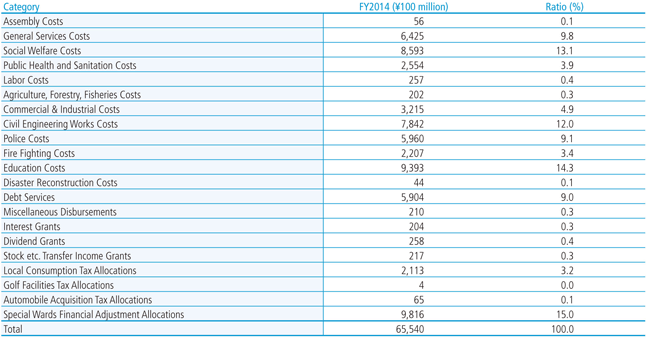
Details of Tokyo Metropolitan Government Expenditure (by Type)
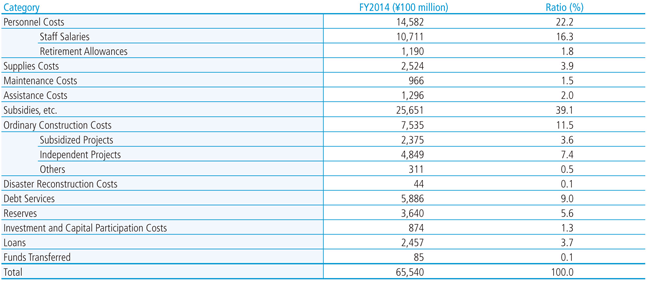
Details and Trends of Tokyo Metropolitan Government Expenditure
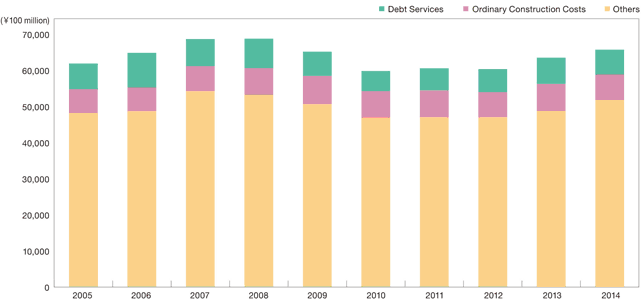
Expenditure Breakdown Comparison
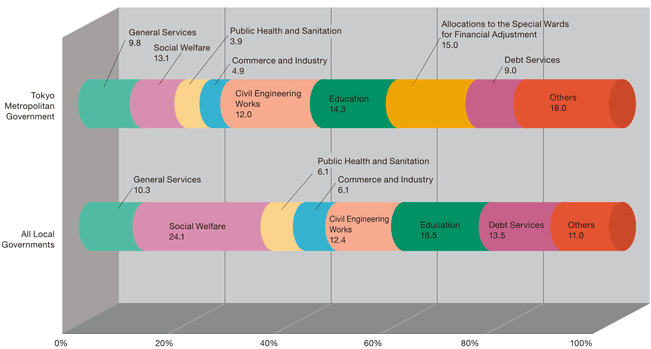
Tokyo Metropolitan Government: FY2014 Settlement of Accounts
All Local Governments: FY2013 Settlement of Accounts














